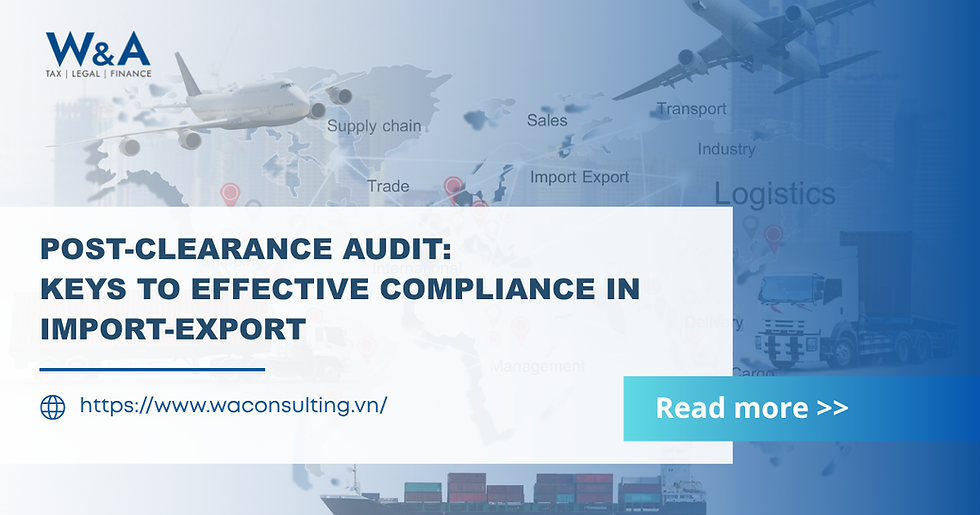Post-Clearance Audit: Keys to Effective Compliance in Import-Export
- phanhoainamba
- Jun 6
- 3 min read
In the context of international economic integration, import-export activities play a crucial role in business development. However, stringent customs compliance requirements demand that businesses meticulously manage their documentation and processes. Post-clearance audits are a vital tool for customs authorities to ensure the accuracy of declarations while supporting businesses in maintaining sustainable operations. This article provides a comprehensive overview of post-clearance audits, from their definition and role to compliance solutions, alongside W&A Consulting’s specialized services to help businesses overcome challenges and optimize import-export processes.

What is a Post-Clearance Audit?
As per Clause 1, Article 77 of the Customs Law 2014, a post-clearance audit involves customs authorities reviewing customs declarations, accounting records, invoices, and related documents after goods have been cleared. The objective is to assess the accuracy, reasonableness, and reliability of declared information, ensuring businesses comply with legal regulations and preventing fraudulent activities.
Post-clearance audits can be conducted within 5 years from the date of customs declaration registration (per Article 78 of the Customs Law 2014), enabling authorities to detect errors and address violations promptly.
Role of Post-Clearance Audits
Post-clearance audits provide multiple benefits for both customs authorities and businesses:
Ensuring Legal Compliance: Identifies and addresses violations such as incorrect commodity codes, customs values, or origins, enhancing businesses’ compliance awareness.
Preventing Revenue Loss: Facilitates tax reassessments and administrative penalties for declaration errors, securing state budget revenue.
Supporting Risk Management: Provides data for customs authorities to develop effective risk management systems, focusing on businesses with signs of violations.
Facilitating Businesses: Compliant businesses may benefit from incentives like the Authorized Economic Operator (AEO) program, reducing clearance times and periodic inspections.
Entities Subject to Post-Clearance Audits
Per regulations, entities subject to post-clearance audits include:
Businesses directly engaged in import-export activities.
Entities entrusted with import-export tasks.
Customs declaration agents.
Postal and express delivery service providers.
Cargo insurance companies for import-export.
Commercial banks are involved in international payments.
Domestic tax authorities and cargo inspection organizations.
Cases Triggering Post-Clearance Audits
According to Article 78 of the Customs Law 2014, post-clearance audits are conducted in the following cases:
Signs of Customs Law Violations: When authorities detect suspicions of inaccurate declarations, commercial fraud, or discrepancies in value or commodity codes.
Risk Management Application: For businesses classified under the customs authority’s risk management system, even without clear violation signs.
Periodic Inspections: To assess declarants’ compliance with customs laws as part of the authorities’ annual audit plan.
Forms of Post-Clearance Audits
Post-clearance audits are conducted in two main forms:
At Customs Authority Premises: Businesses are required to submit documents (customs declarations, contracts, invoices, payment records) for review by customs authorities.
At Business Premises: Customs authorities visit the business to inspect documents, accounting records, and goods (if necessary) to verify declaration accuracy.
Risks of Post-Clearance Audits
Businesses may face the following risks if they fail to comply:
Tax Reassessments: Customs authorities may reassign tax amounts for errors in declared values, commodity codes, or origins.
Administrative Penalties: Fines up to 20% of reassessed tax or a maximum of VND 100 million for customs administrative violations (per Decree 128/2020/ND-CP).
Late Payment Penalties: A penalty of 0.03% per day on overdue tax amounts.
Reputational Impact: Businesses may be classified as high-risk, leading to increased inspection frequency and prolonged clearance times.
Compliance and Risk Mitigation Solutions
To minimize risks and ensure compliance during post-clearance audits, businesses should adopt the following solutions:
Maintain Comprehensive Documentation: Store and manage import-export-related documents (declarations, contracts, invoices, payment records) for at least 5 years.
Conduct Regular Internal Audits: Reconcile data between customs declarations, accounting records, and actual documents to identify errors before audits.
Train Staff: Enhance the awareness and skills of teams regarding customs regulations, particularly the Customs Law 2014 and related decrees.
Leverage Technology: Use electronic document management systems (e.g., AIS or ERP) to improve transparency and efficiency in data management.
Collaborate with Expert Consultants: Work with reputable consulting firms to assess risks, prepare documentation, and support during audits.
W&A Consulting’s Customs and Compliance Services
At W&A Consulting, we provide specialized customs and compliance consulting services to help businesses manage import-export activities effectively. Our team of experts, with 10-20 years of experience in multinational corporations, is committed to delivering comprehensive solutions:
Customs Risk Assessment: Analyze import-export documents and processes to identify risks and propose corrective measures.
Compliance System Development: Establish document and data management processes to ensure compliance with the Customs Law 2014 and related regulations.
Post-Clearance Audit Support: Prepare complete documentation, provide explanations to customs authorities, and assist during audits at business or customs premises.
Let W&A Consulting be your trusted partner in ensuring customs compliance and optimizing import-export operations.
Contact Us for Detailed Consulting
☎️ +84 93 594 8688
📧 Email: nam.phan@waco.com.vn
🌐 Website: https://www.waconsulting.vn/
📌 18th Floor, Vincom Center Đồng Khởi, District 1, Ho Chi Minh City
🏢 2nd Floor, Saigon Paragon Building, Tân Phú Ward, District 7, Ho Chi Minh City




Comments